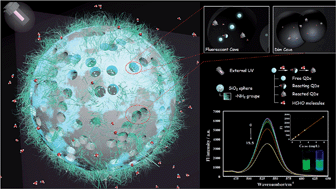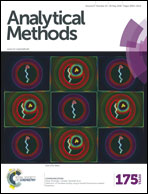Encapsulating quantum dots with amino functionalized mesoporous hollow silica microspheres for the sensitive analysis of formaldehyde in seafood†
Abstract
We developed a hybrid fluorescent material using amino functional mesoporous hollow silica microspheres (MHSM) encapsulated with CdTe quantum dots (QDs). The amino group plays a key role in immobilizing both QDs and formaldehyde in the inner mesoporous hole of MHSM. The present QDs-MHSM shows good fluorescence property and excellent photostability after ultrasonic irradiation in water for several times or stewing for more than 30 days. Its fluorescence intensity is quenched rapidly in the presence of formaldehyde but not by interference with commonly organic solvents. Under the optimal experimental conditions, such as the response time and pH of the solution, a sensitive fluorescence method was developed for the analysis of formaldehyde in seafood based on fluorescence quenching of QDs-MHSM. The linear response range of formaldehyde (R2 = 0.9997) ranged from 0.2 to 15.5 mg L−1 and the detection limit (S/N = 3) was as low as 0.07 mg L−1. The recovery was 99.5% with a relative standard deviation less than 5.0%, which was consistent with that obtained by the China National Standard colorimetric method, suggesting the potential application of this sensitive and simple method in food quality monitoring or other relative fields.


 Please wait while we load your content...
Please wait while we load your content...